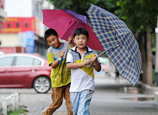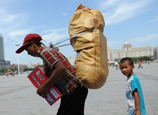
JINAN, June 10 (Xinhua) -- Water from the lower reaches of the Yangtze River, China's longest and world's third longest river, was able to run through the lower reaches of the Yellow River, China's second longest river on Monday noon thanks to the progress of China's south-north water diversion project.
That was a landmark success of the first phase of the eastern route of the south-north water diversion project, which kicked off in 2002 and is expected to send water in the third quarter of 2013.
The water from the Yangtze River is expected to arrive in the Datun Reservoir in east China's Shandong Province, the northern end of the project, within 72 hours, according to the provincial construction management bureau of the south-to-north water diversion project.
Datun Reservoir, located in Wucheng County, is more than 700 km away from its starting point in Yangzhou city of the neighbouring Jiangsu Province to the south of Shandong.
Some 1.5 billion cubic meters of water from the Yangtze River is expected to be sent to Shandong each year after the operation of the first phase of the eastern route project, which will ease the serious water shortage in the booming province.
The south-north water diversion project was first conceived by former Chinese leader Mao Zedong in 1952 and the State Council, or China's Cabinet, approved the ambitious project in December 2002 after debates that lasted nearly a half century.
The project, with an estimated total cost of 500 billion yuan (81 billion U.S. dollars), has aroused global concerns over land use, possible regional climate changes, environmental damage, impact on agriculture and human suffering in the wake of massive relocations.
The project plans to divert 44.8 billion cubic meters of water annually from the Yangtze through eastern, middle and western routes to relieve water shortages in north China by 2050.
The construction of the 1,467-km-long eastern route began in December 2002 and is expected to supply water to northern China by the end of 2013.
















 Seasonal migration of Chinese left-behind children
Seasonal migration of Chinese left-behind children


![]()
